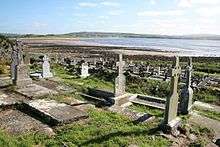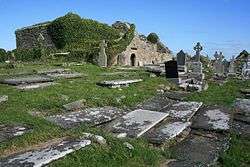Kilmacrehy
| Kilmacrehy Cill Mhic Creiche | |
|---|---|
| Civil parish | |
|
The ruined church of Kilmacreehy | |
 Kilmacrehy | |
| Coordinates: IE 52°56′37″N 9°22′32″W / 52.943694°N 9.375528°WCoordinates: IE 52°56′37″N 9°22′32″W / 52.943694°N 9.375528°W | |
| Country | Ireland |
| County | Clare |

Kilmacrehy (Irish: Cill Mhic Creiche[1]) is a civil parish in County Clare, Ireland. The ruins of the old parish church lie near the coastal village of Liscannor.
Location
Kilmacrehy is part of the historical barony of Corcomroe. It is about 4 miles (6.4 km) to the west of Ennistymon. It is on the north shore of Liscannor Bay on the western coast of Clare. A basaltic promontory called Hag's Head extends into the sea in the extreme west of the parish. From this point the cliffs running to the northeast gradually rise to Moher,[lower-alpha 1] where they are about 600 feet (180 m) above sea level.[3] The parish once had the alias of Quoranna, meaning "the distinct projection", an allusion to the imposing cliffs.[4]
An 1837 account says that the parish contained 5,492 acres (2,223 ha), as applotted under the tithe act, including pasture and arable land fertilized with seaweed.[3] An 1845 account gives the parish a total area of 7,403 acres (2,996 ha), and dimensions of about 3.75 by 3.5 miles (6.04 by 5.63 km).[4]
Townlands
The parish includes the townlands of Ardnacraa, Ardnahea, Ballycotteen North, Ballycotteen South, Ballyea, Ballyheean, Ballyherragh, Ballylaan, Ballymaclinaun, Ballynalackan, Ballysteen, Ballyvorda, Ballyvrislaun, Beaghy, Caherbarnagh, Caherycahill, Cloghaundine, Derreen, Dough, Kilconnell, Kineilty, Laghcloon, Laghvally, Liscannor, Lislorkan North, Lislorkan South, Rannagh, Shingaunagh North, Shingaunagh South, Slievenageeragh and Teeraghbeg.[5]
History
The parish is named after Saint Mac Creiche, who founded several churches in what is now County Clare. The parish church of Kilmacrehy is the only one that bears his name.[6] There is a place on the strand called MacCreiche's bed, and about 200 metres (660 ft) to the northwest is MacCreiche's well.[2]
In 1588 some ships of the Spanish Armada were wrecked on the shore.[3] As of 1831 the population was 3,343. By 1841 it was 4,264 in 673 houses.[4]
The ruins of the old church include several fine specimens of arches and moldings in its walls. The parish holds two ruined castles, Dough and Liscannor.[3] Dough castle was the main seat of O'Connor, Lord of Corcomroe.[2]
Ecclesiastical parishes
There is a holy well near Birchfield dedicated to Saint Bridget.[3] The devotees and people looking for the cure of illness would visit the well on the eve of the first Sunday of August.[2]
In 1834 there were 3,571 Roman Catholics and 24 Protestants.[4] As of 1837 the parish was part of the Catholic district of Liscanor, which also includes the parish of Killaspuglenane.[3]
From 1779 the Church of Ireland vicarage of Kilmacrehy was part of the archdeaconry of Kilfenora, which also included the vicarages of Kilmanaheen, Kilaspughenane, Killeilagh and Kilmoon, and after 1785 included the rectories of Carrune and Killeilagh. The archdeaconry was in the Diocese of Kilfenora, and the province of Cashel.[7]
References
Notes
Citations
Sources
- Carlisle, Nicholas (1810). A Topographical Dictionary of Ireland: Exhibiting the Names of the Several Cities, Towns, Parishes, and Villages ... Collected from the Most Authentic Documents, and Arranged in Alphabetical Order. Being a Continuation of the Topography of the United Kingdom of Great Britain and Ireland. W. Miller. Retrieved 6 March 2014.
- "Cill Mhic Creiche". Placenames Database of Ireland. Retrieved 2014-04-10.
- Frost, James (1893). "Kilmacreehy Parish". The History and Topography of the County of Clare. Sealy, Bryers & Walker. Retrieved 2014-03-06.
- "Kilmacrehy". Parliamentary Gazeteer of Ireland. 1845. Retrieved 2014-03-06.
- Lewis, Samuel (1837). "Kilmacrehy". County Clare: A History and Topography. Retrieved 2014-03-06.
- "Map of Kilmacrehy Parish showing Townlands". Clare County Library. Retrieved 2014-03-06.
- O'Curry, Eugene (1873). Lectures, vol. 2. Williams and Norgate. Retrieved 6 March 2014.
